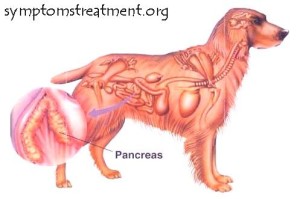 Pancreatitis in dogs occurs when the pancreas of the dog swells. The swelling may range from mild to severe. Dogs whose pancreas swell do not want to eat, are depressed and irritable due to painful abdomens. If the condition is left untreated, the dog may die.
Pancreatitis in dogs occurs when the pancreas of the dog swells. The swelling may range from mild to severe. Dogs whose pancreas swell do not want to eat, are depressed and irritable due to painful abdomens. If the condition is left untreated, the dog may die.
Treatment for pancreatitis in dogs will help the affected dog deal with the symptoms by addressing the underlying cause. This also involves letting the pancreas rest to facilitate recovery. The veterinarian will decide on the appropriate treatment method based on the seriousness and the duration of the disease.
What causes the inflammation of pancreas in dogs?
The inflammation of pancreas is caused by the premature activation of the digestive enzymes secreted by the pancreas. Under normal conditions, these enzymes will only be activated upon reaching the small intestine to help in digestion. However, when these enzymes are prematurely activated into the pancreas instead of the small intestine, the pancreas digests itself resulting to inflammation. What causes the premature activation of the digestive enzymes in the pancreas is not yet fully understood. Even so, there are contributing factors that may give rise to pancreatitis in dogs, and these include:
- Obesity
- High fat diet
- Acute abdominal injury
- Idiopathic Hyperlipidemia
- Diabetes mellitus
- Cushing’s Disease
- Long-term intake of corticosteroids
- Hypothyroidism
- Unhygienic food like garbage food and table scraps

Which dog breeds are prone to pancreatitis?
Although pancreatitis in dogs can affect all dogs, some breeds are more vulnerable to pancreatitis over the others. Some of these are Cocker Spaniels, Miniature Poodles, Silky Terriers, Yorkshire, Miniature Schnauzers and Dachshunds. The condition is more prevalent in female dogs than males and among middle-aged to older dogs. Overweight dogs are at risk too, including diabetic dogs.
What are the different types of dog pancreatitis?
There are two types of pancreatitis in dogs, chronic and acute pancreatitis. Chronic pancreatitis is the milder type of pancreatic disorder while the acute pancreatitis is the more severe type. The chronic type of pancreatitis keeps recurring again and again while the acute type only occur once in the entire lifetime of the dog. Both types are life-threatening and require immediate medical attention. But there is one severe form of pancreatitis in dogs that completely destroys some portion of the pancreas and it is called hemorrhagic pancreatitis or necrotizing pancreatitis. This severe form of dog pancreatitis is deadly which requires early and aggressive treatment.
What are the things observed in dogs with inflamed pancreas?
A dog with an inflamed pancreas shows unusual behavior like standing with their front legs down, resembling a bowing position. The affected dog seems upset and irritable, indicating abdominal pain. Their stool is yellow and looks greasy. Dogs with swelling pancreas have fever, don’t want to eat, seem depressed and vomit. They also find it hard to breathe while their hearts beat really fast. The affected dog may also have dry mouth and sunken eyes which are clear signs of dehydration.
Diagnosis of Pancreatitis in Dogs
There is no definite diagnostic test for pancreatitis in dogs. In fact, the sign and symptoms of the disease are similar to other medical issues like intestinal obstruction, inflammatory bowel disease and acute gastroenteritis. This makes the diagnosis quite confusing. However, the veterinarian will try to diagnose the disease by analyzing the information taken from the dog’s medical history, primarily the food he or she eats, physical exam, X-rays, laboratory tests, abdominal ultrasound and sometimes, biopsy.
How is pancreatitis in dogs treated?
Treatment of dog pancreatitis depends upon the individual dog and the severity of the disease, including the length of time the dog has been ill. The treatment process has three major parts:
- Resting the pancreas
This is the most important part of the treatment process, giving nothing to the dog for several days, not food or water.
- Administration of intravenous fluids
This is done to replace the loss of large amounts of water from the dog’s body due to recurrent diarrhea and vomiting.
- Medications to control the associated symptoms
The dog will be given certain medications to control the associated symptoms like vomiting and pain. Antibiotics may be given as a preventive measure for bacterial infection. Anti-arrhythmic drugs may be administered if the dog experiences cardiac arrhythmias.
If these treatments are ineffective, surgical procedure might be required to drain the infected pancreas.
What can be done to prevent the recurrence of pancreatitis in dogs?
The disease may recur; which can be mild to severe. Several things can be done to prevent this from happening again, and these include:
- Getting rid of predisposing factors.
- Feeding the dog with high-fiber and low-fat diet.
- Avoiding feeding the dog with table scraps and keeping them away from the garbage.
- Putting the dog into a weight loss program.
Pancreatitis in dogs occurs due to inflamed pancreas. The condition requires medical attention no matter how mild the symptoms are. This is because it may lead to more serious complications and even death. The treatment is largely based on the seriousness and the duration of the illness.
I have been exploring for a bit for any high quality articles or blog posts on this kind of area . Exploring in Yahoo I at last stumbled upon this website. Reading this info So i抦 happy to convey that I have a very good uncanny feeling I discovered just what I needed. I most certainly will make sure to do not forget this site and give it a glance regularly.
This is really attention-grabbing, You are an excessively skilled blogger. I’ve joined your feed and stay up for in search of extra of your wonderful post. Also, I have shared your web site in my social networks!
Thanks a lot for providing individuals with an extremely marvellous possiblity to discover important secrets from this blog. It is always so nice plus full of amusement for me personally and my office peers to search the blog particularly 3 times in 7 days to see the new guidance you will have. And lastly, we’re certainly satisfied considering the astounding inspiring ideas you give. Selected two areas in this article are without a doubt the most effective I’ve had.
Wow, marvelous blog layout! How long have you been blogging for? you made blogging look easy. The overall look of your site is wonderful, let alone the content!
Wow! Thank you! I continually wanted to write on my website something like that. Can I take a part of your post to my blog?
Thanks for your tips on this blog. One particular thing I would want to say is that purchasing consumer electronics items on the Internet is nothing new. The fact is, in the past few years alone, the marketplace for online electronics has grown a great deal. Today, you’ll find practically virtually any electronic gizmo and devices on the Internet, including cameras and camcorders to computer parts and video games consoles.
Hello there! This post couldn’t be written any better!Reading through this post reminds me of my old room mate!He always kept chatting about this. I will forwardthis write-up to him. Pretty sure he will have a good read.Many thanks for sharing!
Looking forward to reading more. Great blog article.Really looking forward to read more.
I do not even know how I finished up here, however Iassumed this submit was good. I do not realize who you’re however definitely you’re going tooa well-known blogger should you are not already. Cheers!